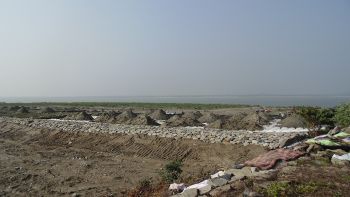Soil Foundations

|
| Soil foundation and embankment in construction in Palashbari, India.
(Image Source: Wikimedia) |
Soil foundations provide a stable and secure base for the dam structure. The foundation must be capable of supporting the weight of the dam and the hydrostatic forces exerted by the reservoir water. The goals include preventing excessive settlement, ensuring uniform bearing capacity, and minimizing the potential for seepage or erosion. The foundation design aims to distribute the loads from the dam structure to the underlying soil in a manner that maintains the integrity and stability of the dam.
There are several key considerations when designing the soil foundation of a dam. These include the strength and compressibility of the foundation soil, its permeability, and its ability to withstand potential failure mechanisms, such as sliding or bearing capacity failure. The characteristics of the foundation soil, including its grain size distribution, mineral composition, and moisture content, influence its engineering properties and behavior. Understanding these properties is crucial for selecting appropriate foundation design strategies, soil improvement techniques, and construction methods.
Various analysis methods are employed in dam engineering to evaluate the behavior and stability of soil foundations. Geotechnical investigations, including soil sampling and laboratory testing, provide valuable data on the engineering properties of the foundation soil. This data is used in analytical and numerical models to assess factors such as settlement, slope stability, and seepage. Methods such as limit equilibrium analysis, finite element analysis, and seepage analysis are applied to evaluate the performance of the foundation and ensure its stability under various loading conditions.
The stability of the soil foundation is of utmost importance for the overall stability and performance of the dam. A weak or unstable foundation can lead to excessive settlement, differential movement, or even catastrophic failure of the dam structure. Adequate foundation stability ensures that the dam can safely resist external forces, including hydrostatic pressure, seismic loads, and changes in reservoir water levels. Proper foundation design and construction measures, such as soil compaction, consolidation, and drainage systems, are essential for maintaining the stability and integrity of the dam.
Continuous monitoring and maintenance of the soil foundation are crucial for dam safety and long-term performance. Where applicable, instrumentation and monitoring systems, including piezometers, settlement gauges, and slope inclinometers, may be utilized to monitor the behavior of the foundation soil and detect any signs of instability or deformations. Regular inspections and maintenance activities, such as slope stabilization measures, erosion control, and drainage system maintenance, are implemented to ensure the ongoing stability and functionality of the soil foundation.
Best Practices Resources
![]() General Design and Construction Considerations for Earth and Rock-Fill Dams (EM 1110-2-2300), USACE
General Design and Construction Considerations for Earth and Rock-Fill Dams (EM 1110-2-2300), USACE
